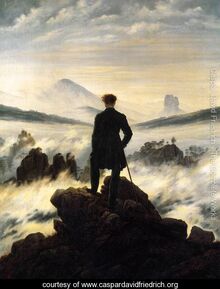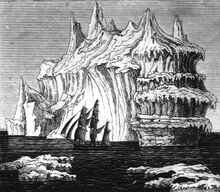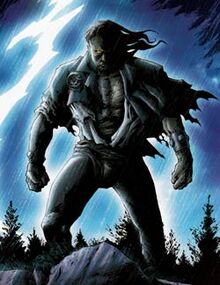During the romantic period, a new genre of literary works was born which sparked imagination and passionate emotions toward nature. Aside from relying solely on nature’s beauty, some works during this period represent nature as a powerful entity which inflicts upon the reader an overwhelming feeling of terror and respect for nature. As explained by the famous statesman, Edmund Burke, in his book, A Philosophical Inquiry into the Origin of Our Ideas of the Sublime and Beautiful, connecting nature and the sublime is to incorporate the essence of astonishment: “The passion caused by the great and sublime in nature...is astonishment; and astonishment is that state of the soul, in which all its motions are suspended with some degree of horror” (Burke 40).[1] Following Burke’s theory and many other famous authors during the romantic period, Mary Wollstonecraft Shelley continued the trend of connecting nature and the sublime by giving her characters one-on-one interactions with nature in the novel, Frankenstein; or, The Modern Prometheus. However, the way in which each character reflects the sublime nature greatly varies in regards to the amount of respect they have towards nature.
Characters and Their Relationship to Nature[]
In the novel, there are three main characters that reflect or work around the natural world: Victor Frankenstein, Captain Robert Walton, and the Creature. Understanding each character’s personality and their relationship to nature is important in evaluating the way each character conveys the sublime moments of nature. The order that these characters will be analyzed depends on their respect towards nature from least to most. Starting with Victor Frankenstein, the view of himself in comparison to nature is at sometimes superior. From the start of his career, Victor is as a self-loving individual putting his desire for knowledge above everything and everyone – even at the expense of his loved ones. As a contrast to Victor, Robert Walton can be seen as neutral. His goals mirror Victor’s but respects nature enough to not let it go too far. Compared to Victor and Walton, the Creature displays the upmost respect for the natural world. Growing up without the guidance of his creator, he looks towards nature like a child respecting his parents. Because all three characters view nature differently, their interactions with nature vary thus reflecting the sublime differently.
Victor at the Peak of Montanvert[]

Friedrich, Caspar David. Wanderer above the Sea of Fog. 1818. Hamburg, Germany. Artble. Web. [2]
A major scene in which nature and the sublime are combined is when Victor goes to the peak of Montanvert. After escaping his troubles to find peace, he reflects upon his astonishment for the grandeur of the natural surroundings:
“From the side where I now stood Montanvert was exactly opposite, at the distance of a league; and above it rose Mont Blanc, in awful majesty. I remained in a recess of the rock, gazing on this wonderful and stupendous scene.” (Shelley 67) [3]
Victor narrates the scene by mentioning two mountains rather than one thus creating an overwhelming experience. It also shows in contrast to how small man is compared to nature. Victor also remains in the “recess” of the rock almost symbolizing the protective “womb” the mountains provide. To capture the sublime moment, Shelley uses words like “awful” as in terms of awe-inspiring and “majesty” to reflect a divine presence. Continuing on with Victor’s depiction of nature and the sublime, his experience becomes muted or only temporary because his personality appears superior or equal to nature.
“My heart, which was before sorrowful, now swelled with something like joy; I exclaimed – ‘Wandering spirits, if indeed ye wander, and do not rest in your narrow beds, allow me this faint happiness, or take me, as your companion, away from the joys of life’.” (Shelley 67)[3]
At this moment, the awe-inspiring views of the mountains and its “glittering” peaks have restored his heart with the swelling of joy. However, he continues to see himself as equal to nature rather subservient to nature. Victor wants nature to be his “companion” rather than his guardian. Even though the awe-inspiring views provide Victor with regained happiness, he brings nature back to a smaller reflection by stating nature’s “narrow beds” rather than “large beds”. From this analysis, it is implied that nature’s impact had only a temporary effect on Victor due to his narcissistic personality. Since readers know that Victor frequently makes mistakes because of his personality, perhaps Shelley is advising her readers to respect nature and its powers unlike Victor.
The Perilous Fog of Walton’s Voyage[]

Untitled, 1827. Artist unknown. Photographic reproduction of an engraving from 'Northern Exposure', 1827. Courtesy of Picture Collection, The Branch Libraries, The New York Public Library.[4]
Moreover, another major scene where nature interacts with the characters is during the beginning of Robert Walton’s voyage. Writing to Mrs. Saville like a travel narrative, he records, in Letter IV, his moments living with nature:
“…we were nearly surrounded by ice, which closed in the ship on all sides, scarcely leaving her the sea room in which she floated. Our situation was somewhat dangerous, especially as we were compassed round by a very thick fog.” (Shelley 13) [3]
As mentioned before, Robert Walton is the character that juxtaposes the personalities of Victor and the Creature. In relation to this passage, the representation of his astonishment regarding nature is mediocre and everything is “somewhat dangerous”. Resembling Victor, he sees nature as an obstacle to his pursuit of knowledge. On the other hand, he focuses on the dangers of the fog and how nature is diminishing an important human quality, vision. Furthermore, this inability to see resembles the moment when the sun and brightness of nature was blinding to the Creature later on in the novel. As a result, this scene may be small, but it is crucial to understanding how a character like Robert Walton interacted with nature and the level of sublime he attributed to it.
The Fierce Wind That Fueled the Creature's Anger[]

Shalvey, Declan. Unknown. N.d. Classical Comics. Grovel. Web.[5]
In addition to the previous scenes, the last that we will discuss is the encounter between the Creature and nature. After having his heart broken by the DeLacey family, the creature is outraged and uses the anger to destroy the cottage. During this moment, he describes his natural surroundings with astonishment for the power and support it gives him: “As the night advanced, a fierce wind arose from the woods…the blast tore along like a mighty avalanche, and produced a kind of insanity in my spirits…The wind fanned the fire, and the cottage was quickly enveloped by the flames which clung to it…” (Shelley 97).[3] Previous to this moment in the novel, the Creature had explained his relationship with nature and how he relied on nature to survive since he didn’t have the guidance of his creator, Victor. For the same reason, the creature elaborates on nature’s power by saying words like “fierce,” “blast,” and “mighty.” Because it “produced a kind of insanity”, this moment shows his astonishment for the power it gave him to burn the cottage down. Even though the Creature most likely would have succeeded without the help of nature, he is overwhelmed with the idea that the “mighty” or magical wind accomplished the task as it “fanned” the flames. This semi-personification of the wind puts nature on a higher pedestal than humans and will aid humans if respected. Because the Creature respects nature, unlike Victor, Shelley uses this moment to convey that nature is sublime and beneficial to humans only if it’s respected. Perhaps this is another moment alluding to “The Rime of the Ancient Mariner,” by Samuel Taylor Coleridge. It resembles how humans shouldn’t maltreat nature, aka “shooting the albatross”, and instead embrace and respect nature for its powers.
Overview[]
On the whole, each of the previously mentioned scenes reflects the sublimity of nature. However, the novel's descriptions of nature depends on the amount of astonishment each character has towards nature. Looking back on nature’s encounter with Victor Frankenstein, Robert Walton, and the Creature, all the descriptions vary differently which is paralleled with the different levels of respect they have towards nature. Victor defies and disrespects nature by creating a new human species; thus his acknowledgment to nature is regarded to be at the same level as himself. Robert Walton meddles into the pursuit of knowledge, similar to Victor, however he respects it enough to “kill no albatross” (Shelley 12).[3] As a result, his astonishment to nature is mediocre as it is always “almost dangerous”. In contrast to the two characters, the Creature was raised with nature thus respecting it the most. Accordingly, his astonishment towards nature is the greatest thus the descriptions are more sublime than the moments described by Victor Frankenstein and Robert Walton. Moreover, what impact does each of these moments have on Mary Shelley’s novel in its entirety? Even though the theme of representing nature and the sublime was very common during the Romantic era, Shelley put a twist on representing nature and the sublime possibly to make it stand out above the rest. After closely analyzing the major scenes in which nature is described in its sublime form, Shelley infers that nature can be beneficial to humans only if the humans respect nature in return. Perhaps with further research on adaptations and appropriations of Frankenstein, this theme of nature and the sublime will continue.
[Contributed by: Alexandrea Riggan]
- ↑ Burke, Edmund. "A Philosophical Inquiry Into the Origin of Our Ideas of the Sublime and Beautiful". George Bell, n.d. Web. 17 Feb 2015. 40-41. <https://books.google.com/books?id=6HFRAAAAYAAJ&dq=is+astonishment;+and+astonishment+is+that+state+of+the+soul,+in+which+all+its+motions+are+suspended+with+some+degree+of+horror.&source=gbs_navlinks_s>.
- ↑ Friedrich, Caspar David. Wanderer above the Sea of Fog. 1818. Hamburg, Germany. Artble. Web. <http://www.artble.com/artists/caspar_david_friedrich/paintings/wanderer_above_the_sea_of_fog>.
- ↑ 3.0 3.1 3.2 3.3 3.4 Shelley, Mary. Frankenstein. 2nd ed. New York: W.W. Norton & Company, 1818. print.
- ↑ Untitled, 1827. Artist unknown. Photographic reproduction of an engraving from 'Northern Exposure', 1827. Courtesy of Picture Collection, The Branch Libraries, The New York Public Library. <http://www.nlm.nih.gov/frankenstein/surrounded.html>.
- ↑ Shalvey, Declan. Unknown. N.d. Classical Comics. Grovel. Web. <http://www.grovel.org.uk/frankenstein-the-graphic-novel/>.
